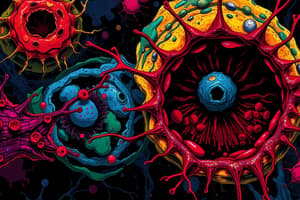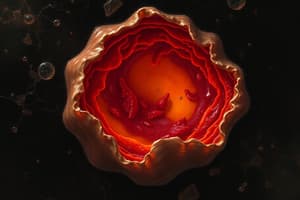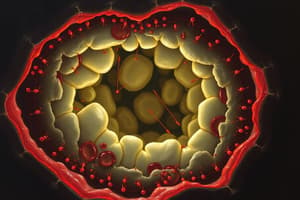Podcast
Questions and Answers
Which of the following best describes the key difference between necrosis and apoptosis?
Which of the following best describes the key difference between necrosis and apoptosis?
- Necrosis is a programmed cell death, while apoptosis is always pathological.
- Both necrosis and apoptosis are always pathological.
- Necrosis is always pathological, while apoptosis can serve normal functions. (correct)
- Both are examples of programmed cell death.
The intensity and duration of a stress stimulus do not affect a cell's resistance to stress.
The intensity and duration of a stress stimulus do not affect a cell's resistance to stress.
False (B)
What is one main field of research related to cell death?
What is one main field of research related to cell death?
understanding the molecular mechanisms of cell death and manipulating cell viability
When a stimulus can no longer be tolerated, the result is ______
When a stimulus can no longer be tolerated, the result is ______
Match the following terms with their description:
Match the following terms with their description:
Which of the following is a characteristic of necrosis?
Which of the following is a characteristic of necrosis?
Apoptosis is an acute event that is completed in a few minutes.
Apoptosis is an acute event that is completed in a few minutes.
What is released from necrotic cells that causes inflammation?
What is released from necrotic cells that causes inflammation?
In necrosis, the nucleus may undergo shrinkage and increased basophilia in a process called ______.
In necrosis, the nucleus may undergo shrinkage and increased basophilia in a process called ______.
Flashcards
Necrosis
Necrosis
Accidental cell death caused by a hostile environment that the cell cannot adapt to. This results in the cell losing membrane integrity and leaking its contents, triggering inflammation.
Pyknosis
Pyknosis
A type of cell death that is characterized by the cell shrinking and becoming more dense, forming a solid mass of chromatin.
Karyorrhexis
Karyorrhexis
The process of the pycnotic nucleus fragmenting into smaller pieces.
Karyolysis
Karyolysis
Signup and view all the flashcards
Apoptosis
Apoptosis
Signup and view all the flashcards
What is Necrosis?
What is Necrosis?
Signup and view all the flashcards
What is Apoptosis?
What is Apoptosis?
Signup and view all the flashcards
What determines a cell's resistance to stress?
What determines a cell's resistance to stress?
Signup and view all the flashcards
What happens if a cell can't handle stress?
What happens if a cell can't handle stress?
Signup and view all the flashcards
Why is cell death important?
Why is cell death important?
Signup and view all the flashcards
Study Notes
Cell Death Processes: Necrosis and Apoptosis
- Necrosis and apoptosis differ in their morphology, mechanisms, and roles in physiology and disease.
- Necrosis is always a pathological process, while apoptosis serves many normal functions and is not necessarily associated with cell injury.
Biochemical Mechanisms of Cell Death Induced by Ischemia
- Ischemic necrosis of cardiac myocytes is caused by the loss of selective membrane permeability, leading to membrane damage.
- Interruption of blood supply decreases delivery of O₂ and glucose.
- Anaerobic glycolysis leads to overproduction of lactate, lowering intracellular pH and reducing ATP levels.
- Distorted plasma membrane pump activities due to lack of ATP, and intracellular acidosis skews the ionic balance of the cell. The Na/K pump becomes inactive and the Na/H pump becomes active, resulting in sodium accumulation.
- Increased intracellular sodium activates the Na/Ca pump, causing calcium accumulation.
- The increased intracellular Ca++ activates PLA2, leading to phospholipid degradation and activation of proteases, thus further increasing membrane permeability.
- Lack of oxygen impairs mitochondrial electron transport, decreasing ATP synthesis, and facilitating ROS production (lipid peroxidation damaging the mitochondrial membrane).
- Mitochondrial damage releases cytochrome c into the cytosol and initiates the apoptotic cascade.
Role of Calcium in the Pathogenesis of Apoptotic Cell Death
- Calcium release from the ER can induce apoptosis by opening the MPTP and releasing cytochrome c.
- Calcium can also activate caspase 12, which then activates caspase 9 (apoptosome) and consequently caspase 3.
Types of Necrosis
- Coagulative necrosis: Characterized by a firm texture, the architecture of the dead tissue is preserved.
- Liquefactive necrosis: The necrotic material becomes creamy yellow. It usually occurs in the central nervous system or in focal bacterial infections, because microbes stimulate the accumulation of leukocytes and the release of enzymes from these cells.
- Caseous necrosis: A mix between coagulative and liquefactive necrosis, characterized by a friable white appearance. Focal tuberculous infections often exhibit this type.
- Fat necrosis: Areas of fat destruction, often occurring in acute pancreatitis.
- Fibrinoid necrosis: A special form of necrosis related to chronic inflammatory processes involving blood vessels, characterized by fibrin deposits and a bright pink, amorphous appearance in H&E stains.
- Gangrenous necrosis: Not a pattern of cell death. Usually associated with a lost blood supply to a limb (typically coagulative necrosis) which may be further complicated by bacteria and the resulting liquefactive necrosis.
Mechanisms of Apoptosis
- Two distinct pathways converge on caspase activation: the mitochondrial pathway and the death receptor pathway.
- Intrinsic pathway: Caused by stimuli internally to the cell, often involving the mitochondria, ROS, and calcium release.
- Extrinsic pathway: Triggered by external stimuli, often involving death receptors such as TNF, TRAIL, and FAS.
### Morphological Features of Apoptosis
- Cellular shrinkage, cytoplasm is dense, organelles are more tightly packed.
- Chromatin condensation, chromatin aggregates peripherally under the nuclear membrane into dense masses of various shapes.
- Formation of apoptotic bodies, fragmentation of the cell into membrane-bound apoptotic bodies. These contain cytoplasmic components and may or may not contain a nuclear fragment.
- Phagocytosis of apoptotic cells or bodies, usually accomplished by macrophages.
### Different Steps Involved in Efficient Apoptotic Cell Clearance
- Phagocyte recruitment/attraction to the site of apoptosis, driven by signal release from the apoptotic cell.
- Recognition of "eat-me" signals on apoptotic cells, often involves phosphatidylserine exposure and recognition by phagocytes.
- Cytoskeletal rearrangements and internalization of the apoptotic cell.
- Release of anti-inflammatory cytokines, such as TGF-β, IL-10.
Studying That Suits You
Use AI to generate personalized quizzes and flashcards to suit your learning preferences.




